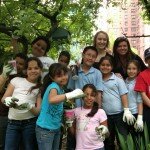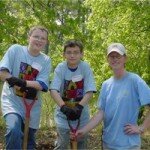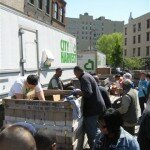As the school year comes to a close, you might be wondering what to do with your kids this summer.
May we recommend volunteering?
You can ensure that a child’s volunteering experience is positive and memorable!
By implementing a few simple but effective tips and strategies, you can ensure that young volunteers leave their service project feeling inspired and empowered to continue doing good work.
1. Be cognizant of word choice
Children are developing and growing their vocabulary each day.
If you feel a word may not be as developmentally appropriate as another word, substitute it or explain the concept the word conveys. Alternately, choose two or three words or terms to explain the same concept.
For example, when explaining volunteering to a child who is six, consider helping the child make a connection.
“Volunteering is when you do something nice for someone else — maybe even someone you don’t even know – and you don’t ask for anything in return.”
2. Model or show final results
 Give children something to work towards.
Give children something to work towards.
Many children, especially under the age of nine, are not yet at the developmental stage in which they can “imagine” what something will be like at a later point.
When working with a child on a craft-type project, have a completed example on hand.
When working on a project where the final product cannot be shown, describe the desired outcome using steps and descriptive terms that are on the child’s level.
3. Reinforce success
Continually remind children that they are on the right track.
Positive reinforcement — “good job” or “you are an amazing volunteer” — is a tactic that gives a child the assurance and motivation that they are going in the right direction.
It also further helps the young person experience the joy that volunteering and giving can bring. However, be specific in your praise.
“Your message about peace is beautiful” or “This yellow card you made will really cheer somebody up!”
4. Provide constructive feedback
Do not hesitate to correct a young person if they are off track.
Allowing a child to proceed if he or she is doing their assigned job incorrectly is less beneficial than correcting them.
Providing constructive feedback will ultimately allow them to be successful in the end and have a positive volunteer experience.
One way to phrase correction is to say,
“This looks really great, but let me show you something that will make it even better.”
5. Stay age-appropriate
Consider the participant’s age as it relates to their developmental level.
Sharing instructions or even defining what it means to volunteer to a young person who is six differs from sharing the same message with a young person who is twelve.
With younger children (ages six to eight), give directions that are broken down into steps. It is difficult for a child who is six to fully comprehend a set of complex instructions presented as a whole. However, don’t underestimate a young person’s ability to understand instruction by speaking to them below their level.
Take Action! Search for a project, evaluate the ones you find, start your own or join a Kids Care Club!
 By Mills with a bit of help from Keller and Ward – an 8 year-old writes a few words about a recent clean-up day at Howard Finster’s Paradise Gardens in Summerville, Georgia
By Mills with a bit of help from Keller and Ward – an 8 year-old writes a few words about a recent clean-up day at Howard Finster’s Paradise Gardens in Summerville, Georgia


 3. Teaches life skills
3. Teaches life skills
 Give children something to work towards.
Give children something to work towards.


 Children for Children, Kids Care Clubs, HandsOn Schools, and our HandsOn Action Center-driven youth programs – all under one banner. We are scaling the success of the HandsOn model and putting youth at the center of change through service. We saw the impact of this next generation throughout the country last weekend.
Children for Children, Kids Care Clubs, HandsOn Schools, and our HandsOn Action Center-driven youth programs – all under one banner. We are scaling the success of the HandsOn model and putting youth at the center of change through service. We saw the impact of this next generation throughout the country last weekend. They used exercise in their dance routines and taught lessons about a proper diet to their peers through performance.
They used exercise in their dance routines and taught lessons about a proper diet to their peers through performance.


